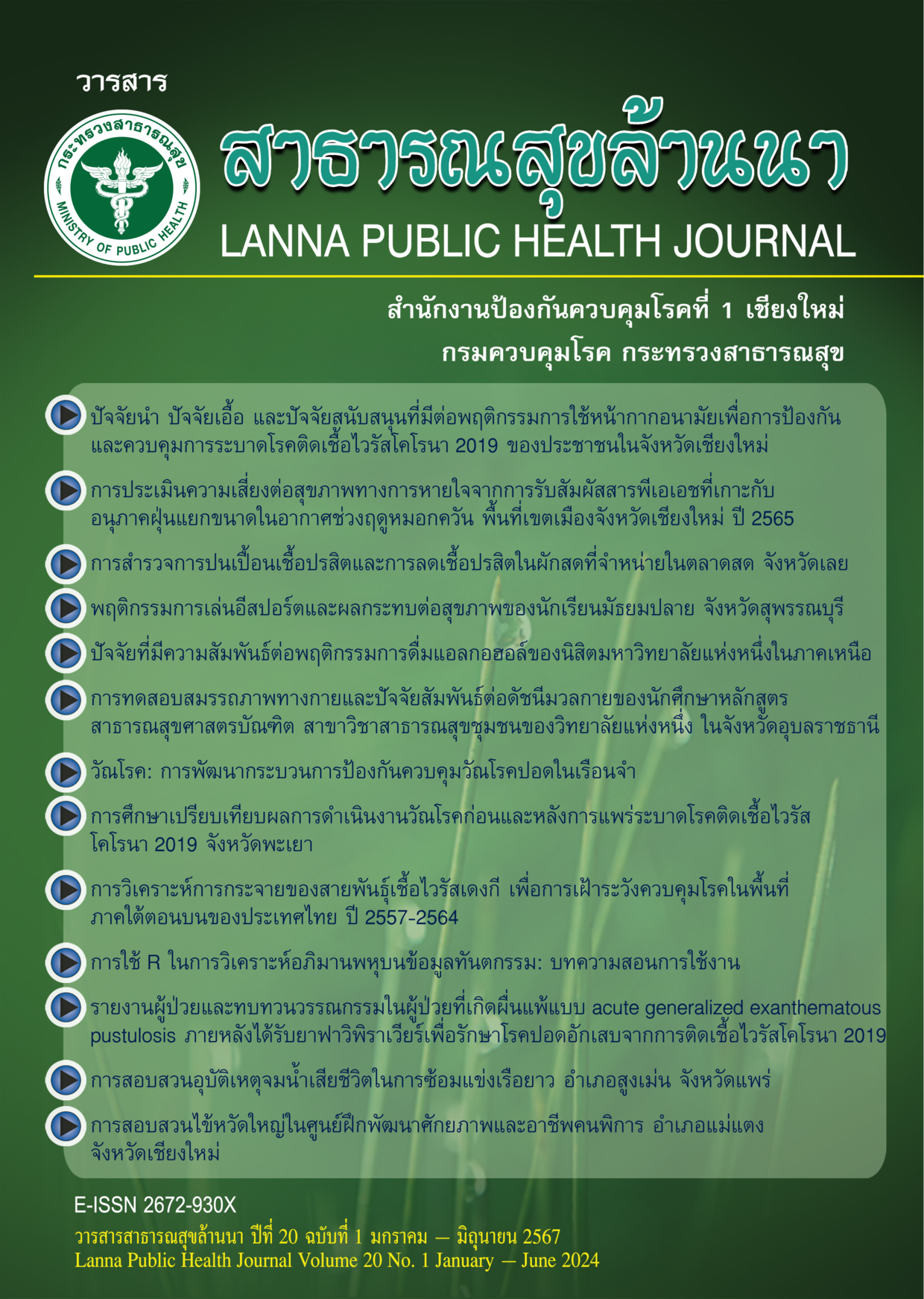การประเมินความเสี่ยงต่อสุขภาพทางการหายใจจากการรับสัมผัสสารพีเอเอช ที่เกาะกับอนุภาคฝุ่นแยกขนาดในอากาศช่วงฤดูหมอกควัน พื้นที่เขตเมืองจังหวัดเชียงใหม่ ปี 2565
คำสำคัญ:
ความเสี่ยงต่อสุขภาพจากการหายใจ, อนุภาคฝุ่นแยกขนาด, สารพีเอเอช, ฤดูหมอกควันบทคัดย่อ
หมอกควันในฤดูแล้งทางภาคเหนือจะแขวนลอยทั้งฝุ่นและละอองสารก่อให้เกิดวิกฤติต่อระบบทางเดินหายใจ การวิจัยนี้มีวัตถุประสงค์เพื่อศึกษาปริมาณอนุภาคฝุ่นแยกขนาด และความเข้มข้นของสารพอลิไซคลิกอะโรมาติกไฮโดรคาร์บอนที่เกาะกับอนุภาคฝุ่นแต่ละขนาดในอากาศ และประเมินความเสี่ยงต่อสุขภาพจากการรับสัมผัสสารพีเอเอชในอนุภาคฝุ่นจากการหายใจ โดยเก็บตัวอย่างอนุภาคฝุ่นต่อเนื่อง 48 ชั่วโมงด้วยเครื่องเก็บตัวอย่างอนุภาคฝุ่นที่สามารถแยกอนุภาคได้ 9 ช่วงในอำเภอเมือง จังหวัดเชียงใหม่ ช่วงฤดูหมอกควัน ปี 2565 (กุมภาพันธ์-เมษายน) วิเคราะห์หาความเข้มข้นของสารพีเอเอช 16 ตัว โดยใช้เครื่องแก๊สโครมาโทรกราฟี-แมสสเปกโทรเมตรี และประเมินความเสี่ยงต่อสุขภาพทางการหายใจตามแนวทางขององค์กรพิทักษ์สิ่งแวดล้อมอเมริกาพบความเข้มข้นฝุ่นรวมทั้ง 9 ขนาด ระหว่าง 36.86-126.87 มคก./ลบ.ม. (เฉลี่ย 84.28±27.32 มคก./ลบ.ม.) โดยอนุภาคฝุ่นขนาด 0.65-0.43 ไมครอน มีสัดส่วนสูงสุด ร้อยละ 18.08 สารพีเอเอชรวมที่พบใน PM10 มีความเข้มข้นระหว่าง 1.30-3.19 นนก./ลบ.ม. (เฉลี่ย 2.14±0.51 นนก./ลบ.ม.) โดยพบสัดส่วนสูงสุดในอนุภาคฝุ่นขนาด 0.60.43 ไมครอน ร้อยละ 20.37 ผลการประเมินความเสี่ยงต่อสุขภาพจากการรับสัมผัสสารพีเอเอชผ่านการหายใจ พบค่าความเสี่ยงในระดับปานกลาง มีค่าเฉลี่ยความเสี่ยง 7.19x10-5 และพบค่าความเป็นพิษสูงสุดในฝุ่นละเอียดที่มีขนาดเล็กกว่า 2.1 ไมครอนเมื่อพิจารณาค่าความเสี่ยง (ILCR) ตามกลุ่มวัยพบว่า เด็กอายุ 1-15 ปี มีค่าความเสี่ยงสูงกว่าผู้ใหญ่อายุ 16-70 ปี 1-2 เท่า ดังนั้นหากความเข้มข้นของฝุ่นละเอียดสูงขึ้นจะเพิ่มความเสี่ยงต่อกลุ่มอาการระบบทางเดินหายใจและความเสี่ยงต่อการเป็นมะเร็งจากการหายใจมากขึ้นในกลุ่มวัยเด็ก
เอกสารอ้างอิง
กรมอุตุนิยมวิทยา กระทรวงดิจิทัลเพื่อเศรษฐกิจและสังคม. (2565). ปรากฏการณ์เอลนีโญ-ลานีญา [ออนไลน์]. [สืบค้นเมื่อ 1 มีนาคม 2567]; แหล่งข้อมูล: https://www4.tmd.go.th/programs%5Cuploads%5Cphenomena%5C%E0%CD%C5%B9%D4%E2%AD_%C1%A1%C3%D2%A4%C12565.pdf
สมพร จันทระ และคณะ. (2561). โครงการการติดตามตรวจสอบการเผาในที่โล่งในภาคเหนือของประเทศไทยสำหรับการประเมินการปล่อยและการเคลื่อนที่ของมลพิษทางอากาศเพื่อการวางแผนการจัดการปัญหาหมอกควัน: รายงานฉบับสมบูรณ์. สำนักงานคณะกรรมการส่งเสริมวิทยาศาสตร์ วิจัยและนวัตกรรม. (เอกสารอัดสำเนา).
Bootdee, S., & Muenmee, S. (2021). Health Risk Assessment of Exposure PM2.5 from Industrial Area in Pluak Daeng district, Rayong province. Health Science, Science and Technology Reviews, 14(3), 95-110. [cited 2024 March 1]; Available from: https://li01.tci-thaijo.org/index.php/journalup/article/view/248513
Goudarzi, G., Baboli, Z., Moslemnia, M., & et al. (2021). Assessment of incremental lifetime cancer risks of ambient air PM10-bound PAHs in oil-rich cities of Iran. Journal of Environmental Health Science & Engineering, 19(1), 319-330. [cited 2022 January 5]; Available from: https://link.springer.com/article/10.1007/s40201-020-00605-6
Insian, W., Yabueng, N., Wiriya, W., & Chantara, S. (2022). Size-fractionated PM-bound PAHs in urban and rural atmospheres of northern Thailand for respiratory health risk assessment. Environmental Pollution, 293: 118488. [cited 2023 April 5]; Available from: https://doi.org/10.1016/j.envpol.2021.118488
Kawichai, S., & Bootdee, S. (2022). Health Risk Assessment on Exposure to PM2.5-bound PAHs from an Urban-industrial Area in Rayong City, Thailand. Open Access Macedonian Journal of Medical Sciences, 10(E), 1-10. [cited 2023 April 5]; Available from: https://doi.org/10.3889/oamjms.2022.9977
Kim, K. H., Kabir, E., & Kabir, S. (2015). A review on the human health impact of airborne particulate matter. Environment International, 74, 136-43. [cited 2022 January 5]; Available from: https://doi.org/10.1016/j.envint.2014.10.005
Li, H., Li, H., Zhang, L., & et al. (2019). High cancer risk from inhalation exposure to PAHs in Fenhe Plain in winter: A particulate size distribution-based study. Atmospheric Environment, 216, 116924. [Cited 2024 January 8]; Available from: https://doi.org/10.1016/j.atmosenv.2019.116924
Löndahl, J., Pagels, J., Swietlicki, E., Zhou, J., Ketzel, M., Massling, A., & Bohgard, M. (2006). A set-up for field studies of respiratory tract deposition of fine and ultrafine particles in humans. Journal of Aerosol Science, 37, 1152-1163. [cited 2021 December 20]; Available from: https://doi.org/10.1016/j.jaerosci.2005.11.004
Nisbet, I. C. T., & LaGoy, P. K. (1992). Toxic equivalency factors (TEFs) for polycyclic aromatic hydrocarbons (PAHs). Regulatory Toxicology and Pharmacology, 16, 290-300.
Pongpiachan, S. (2016). Incremental Lifetime Cancer Risk of PM2.5 Bound Polycyclic Aromatic Hydrocarbons (PAHs) before and after the Wildland Fire Episode. Aerosol and Air Quality Research, 16: 2907-2919. [cited 2022 July 10]; Available from: https://doi.org/10.4209/aaqr.2015.01.0011
Sarigiannis, D., Karakitsios, S. P., Zikopoulos, D., Nikolaki, S., & Kermenidou, M. (2015). Lung cancer risk from PAHs emitted from biomass combustion. Environmental Research, 137, 147-56. [cited 2021 December 20]; Available from: https://doi.org/10.1016/j.envres.2014.12.009
Tadsanaprasittipol, A., Tonrub, P., Beverland, IJ., & Kalin, RM. (2021). Characterization of PM10-Bound Polycyclic Aromatic Hydrocarbons and Associated Carcinogenic Risk in Bangkok, Thailand. Applied Sciences, 11(10):4501. [cited 2022 July 10]; Available from: https://doi.org/10.3390/app11104501
Thepnuan, D., Chantara, S., Lee, C. T., Lin, N. H., & Tsai, Y. I. (2019) Molecular markers for biomass burning associated with the characterization of PM2.5 and component sources during dry season haze episodes in Upper South East Asia. Sci Total Environ, 658, 708-722. [cited 2021 December 20]; Available from: https://doi.org/10.1016/j.scitotenv.2018.12.201
Thepnuan, D. & Chantara S. (2020). Characterization of PM2.5–bound Polycyclic Aromatic Hydrocarbons in Chiang Mai, Thailand during Biomass Open Burning Period of 2016. Applied Environmental Research, 42(3), 11-24. [cited 2021 December 20]; Available from: https://doi.org/10.35762/AER.2020.42.3.2
U.S. EPA. (2005). Guidelines for Carcinogen Risk Assessment. Risk Assessment Forum, Washington DC. [cited 2021 December 20]; Available from: https://www.epa.gov/risk/guidelines-carcinogen-risk-assessment
WHO. (2000). Air Quality Guideline for Europe, 2nd ed. WHO, Copenhagen. WHO Regional Publications 2000: European series, NO.91. [cited 2021 December 20]; Available from: https://www.who.int/publications/i/item/9789289013581
Wang, R., Liu, G., Sun, R., & et al. (2018). Emission characteristics for gaseous- and size-segregated particulate PAHs in coal combustion flue gas from circulating fluidized bed (CFB) boiler. Environmental Pollution, 238, 581-589. [Cited 2022 July 10]; Available from: https://doi.org/10.1016/j.envpol.2018.03.051
Wiriya, W., Prapamontol, T., & Chantara, S. (2013). PM10-bound polycyclic aromatic hydrocarbons in Chiang Mai (Thailand): Seasonal variations, source identification, health risk assessment and their relationship to air-mass movement. Atmospheric Research, 124, 109-122. [cited 2023 April 5]; Available from: https://doi.org/10.1016/j.atmosres.2012.12.014
Yabueng, N., Wiriya, W., & Chantara, S. (2020). Influence of zero-burning policy and climate phenomena on ambient PM2.5 patterns and PAHs inhalation cancer risk during episodes of smoke haze in Northern Thailand. Atmospheric Environment, 232. [cited 2022 January 5]; Available from: https://doi.org/10.1016/j.atmosenv.2020.117485
Yin, G., Liu, C., Hao, L., et al. (2019). Associations between size-fractionated particle number concentrations and COPD mortality in Shanghai, China. Atmospheric Environment, 214. [cited 2022 January 5]; Available from: https://doi.org/10.1016/j.atmosenv.2019.116875
Zhang, J., Yang, L., Ledoux, F., & et al. (2019). PM2.5-bound polycyclic aromatic hydrocarbons (PAHs) and nitrated PAHs (NPAHs) in rural and suburban areas in Shandong and Henan Provinces during the 2016 Chinese New Year's holiday. Environmental Pollution, 250, 782-791. [cited 2022 January 5]; Available from: https://doi.org/10.1016/j.envpol.2019.04.040








